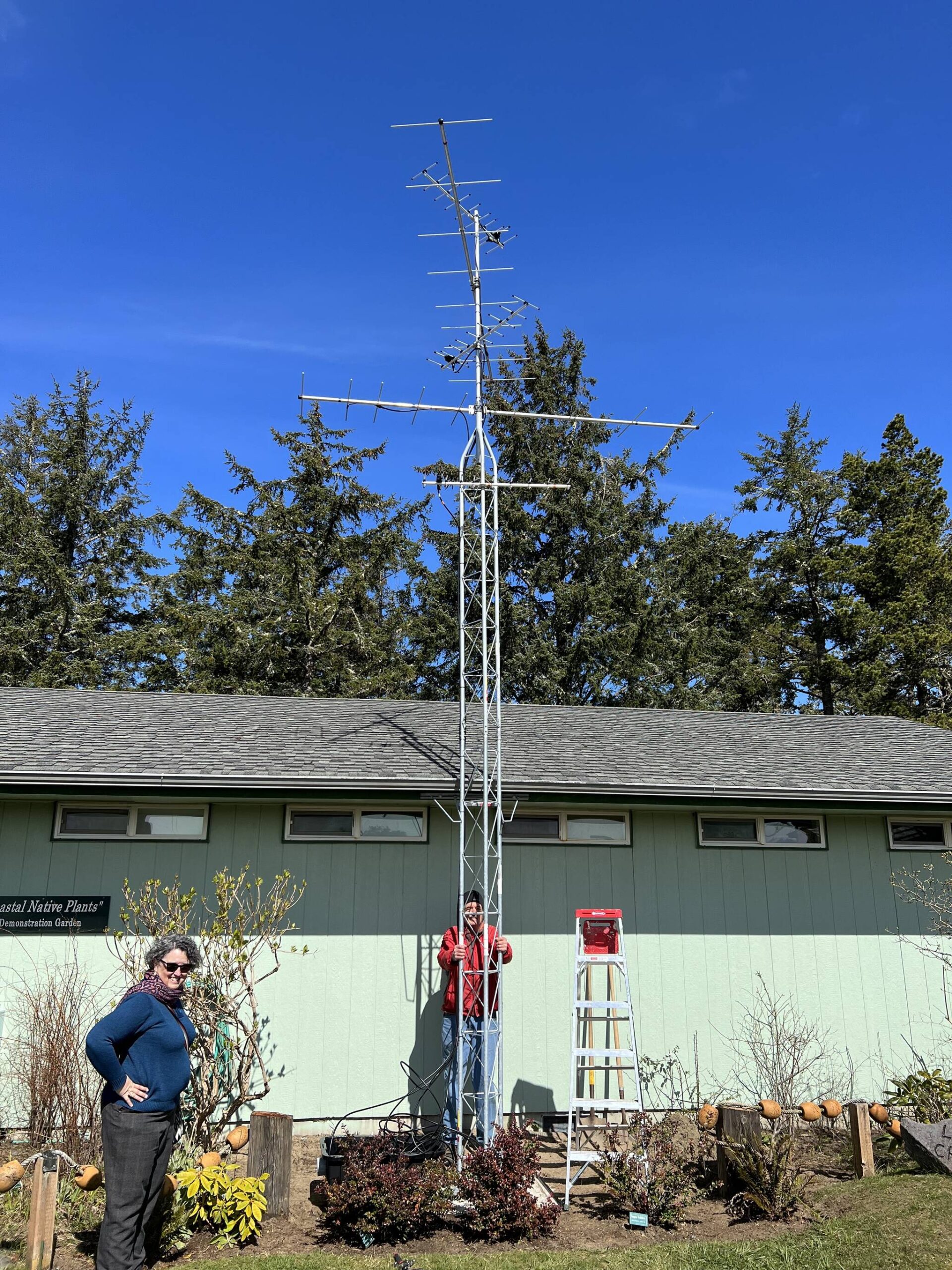On Monday, three biologists hoisted a 26-foot-tall steel tower, with radio antenna poking out like the branches of the nearby Sitka spruce trees, and fastened it to the side of the Coastal Interpretive Center. They plugged its black wires into a small metal box buried in the nearby mulch, and the tower was ready.
But it might take six weeks for the first signals to arrive, riding on the backs — and wrapped around the legs — of shorebirds.
There are nearly 1,500 similar towers in 34 different countries — a system called the Motus Wildlife Tracking System, built to map the massive migrations of shorebirds and other winged creatures that travel thousands of miles from South America and Mexico to Alaska. In Ocean Shores, the newest addition will pick up shorebirds as they swarm into the mudflats, or continue up the coast of Grays Harbor each spring and fall.
The Grays Harbor National Wildlife Refuge is a key area for Red Knots and other shorebirds to rest and eat during spring migration. The area is a designated site of hemispheric importance by the Western Hemisphere Shorebird Reserve Network.
But many shorebird populations are in decline.
Scientists want to find out where, and when, the birds go on their journey to the arctic, and how a changing climate might alter, or is altering, that fragile pilgrimage.
When birds cross political and geographical borders, conserving them requires collaboration, said Barbara Hayford, executive director of the Coastal Interpretive Center. The Motus website is managed by Birds Canada, a nonprofit with a focus on citizen science, but involvement spans “federal and state agencies geographically, institutionally across these organizations, and amongst different universities and colleges,” Hayford said.
Last year Jim Chu, migratory species specialist and international programs manager with the U.S. Forest Service, reached out to Hayford about setting up a tower at the center.
“I’d do this if it were my house,” Hayford said. “But running this institution, I think this really elevates our role in local and regional conservation and science, which is kind of what a natural history museum should be doing anyway.”
Hayford said the tower will become part of future exhibits and presentations at the center. She invited the public to view and learn about the new tower on Monday. The public can also view data collected by the tower — and track migrations of individual shorebirds — on the Motus website.
“It’s a great educational tool for people that use the interpretive center because they can use it in real time as birds fly overhead,” Chu said.
Here’s the gist: a researcher — whether it be from a university, government agency, nonprofit or otherwise — plants radio tags on a group of shorebirds. The tags are so lightweight that similar devices have been used to track Monarch butterflies, according to Vanessa Loverti, regional shorebird manager for the U.S. Fish and Wildlife Service.
Each tag is unique to an individual bird and paired with a specific research project. The tags automatically emit a radio frequency, which is captured if a bird flies within a few miles of a Motus tower.
If a bird is traveling from Mexico to Alaska, for example, it might register on dozens of towers along the West Coast. From those radio hits, the Motus system creates an estimated migration route for each bird.
The more towers that exist, the more precise those maps become.
“We’re just filling in a gap for the whole Pacific Flyway,” Hayford said, naming the major migration route stretching from South America to Alaska.
The new tower makes four on the Twin Harbors — over the last few years towers went up near Bowerman Basin, Tokeland and Oysterville. But the West Coast network is relatively sparse compared to the rest of the continent. The goal is to add 1,000 towers to the network in the next eight years, according to a plan released by Birds Canada.
Chu said the Ocean Shores tower was installed with a certain species in mind: the Red Knot. Numbers of the mid-sized shorebirds with rosy plumage have declined dramatically on the East Coast in recent years. The same trend, while to a much lesser extent, has happened along the Pacific coast. Loverti said there are only 12,000 of the Red Knot Pacific subspecies, roselaari, in the world.
Some of those birds spend their winters at Guerrero Negro, Mexico, another key site. Chu said researchers tracking Red Knots from Guerrero Negro hope the birds will register on the tower in Ocean Shores. Those researchers will also visit the tower this spring, Chu said.
Many of the birds nest near the Copper River Delta in Alaska. This tower will also benefit scientists there, said Nick Docken, a wildlife technician with the Chugach National Forest in Alaska, where he’s helped install two other Motus towers.
Hayford hopes the tower will be an educational tool for young people.
“I think what made me really excited was thinking we could connect some of the schoolkids here to their counterparts who are doing outreach and education in other countries,” Hayford said. “It really increases the international scope.”
When Chu, Docken and Loverti, with the help of a few others, lifted the sturdy tower on Monday, they grimaced under the weight. Built to withstand the wind, this one is the “Cadillac” of Motus towers, Chu said.
“We all share the same birds so it’s not enough that we just do things ourselves, we need to work together,” Chu said.
Contact reporter Clayton Franke at 406-552-3917 or clayton.franke@thedailyworld.com.


